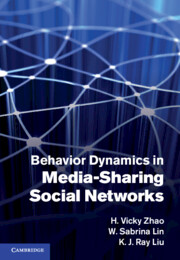Book contents
- Frontmatter
- Contents
- Preface
- Part I Introduction
- 1 Introduction to media-sharing social networks
- 2 Overview of multimedia fingerprinting
- 3 Overview of mesh-pull peer-to-peer video streaming
- 4 Game theory for social networks
- Part II Behavior forensics in media-sharing social networks
- Part III Fairness and cooperation stimulation
- Part IV Misbehaving user identification
- Part V Media-sharing social network structures
- References
- Index
4 - Game theory for social networks
from Part I - Introduction
Published online by Cambridge University Press: 28 April 2011
- Frontmatter
- Contents
- Preface
- Part I Introduction
- 1 Introduction to media-sharing social networks
- 2 Overview of multimedia fingerprinting
- 3 Overview of mesh-pull peer-to-peer video streaming
- 4 Game theory for social networks
- Part II Behavior forensics in media-sharing social networks
- Part III Fairness and cooperation stimulation
- Part IV Misbehaving user identification
- Part V Media-sharing social network structures
- References
- Index
Summary
Game theory is the mathematical study of cooperation and conflict. It provides a distinct and interdisciplinary approach to the study of human behavior and can be applied to any situation in which the choice of each player influences other players' utilities, and in which players take this mutual influence into consideration in their decision making processes. Such strategic interaction is commonly used in the analysis of systems involving human beings, such as economy, sociology, politics, and anthropology. Game theory is a very powerful conceptual and procedural tool to investigate social interaction, such as the rules of the game, the informational structure of the interactions, and the payoffs associated with particular user decisions. Game theory can be applied to all behavioral disciplines in a unified analytical framework. In the later chapters of this book, game theory will be the main tool for modeling and analyzing human behavior in media-sharing social networks. In this chapter we introduce the basic and most important concepts of game theory that will be used extensively in this book.
The idea of game theory was first suggested by Emile Borel, who proposed a formal theory of games in 1921. Later in 1944, the mathematician, John von Neumann and the economist Oskar Morgenstern published Theory of Games and Economic Behavior, which provided most of the basic noncooperative game terminologies and problem setups that are still in use today, such as two-person zero-sum games.
- Type
- Chapter
- Information
- Behavior Dynamics in Media-Sharing Social Networks , pp. 41 - 54Publisher: Cambridge University PressPrint publication year: 2011



